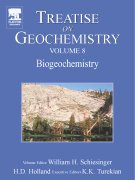
James B. Duke Professor of Biogeochemistry
Dean, Nicholas School of the Environment and Earth Sciences
A 237 Levine Science Research Center
Duke University
Durham, NC 27708-0329
USA
E-mail: schlesin@duke.edu

Volume 8. Biogeochemistry | Next |
"Most of the chapters in this volume are easy and agreeable to read. They avoid long historical description of the evolution of the subject and are generally well focused on the latest developments of our knowledge. This is well reflected in the references cited which are mainly covering the last ten years (except for chapters 3 and 4). (...) The Treatise on Geochemistry is without any doubt a very useful reference book for a large scientific community and especially for students and teachers." (Prof. Roland Wollast†, Oceanographie Chimique, Universite Libre de Bruxelles, Brussels, Belgium)

|
William
H. Schlesinger James B. Duke Professor of Biogeochemistry Dean, Nicholas School of the Environment and Earth Sciences A 237 Levine Science Research Center Duke University Durham, NC 27708-0329 USA E-mail: schlesin@duke.edu |

|
 Click here to see a sample chapter of this volume
Click here to see a sample chapter of this volume
Final contents |
About the editor |
For the past 3.8 billion years, the geochemistry of the Earth's surface - its atmosphere, waters and exposed crust - has been determined by the presence of biota. Photosynthetic organisms exposed the Earth's surface to oxygen, denitrifying bacteria have maintained the nitrogen concentration in Earth's atmosphere, and land plants have determined the rate of chemical weathering. Life determines the global biogeochemical cycles of the elements of biochemistry, especially C, N, P and S. Volume 8 traces the origin and impact of life on the geochemistry of the Earth's surface, with special emphasis on the current human impact on global biogeochemical cycles.
Privacy Policy |
Terms and Conditions |
Feedback
Copyright © 2004 Elsevier B.V. All rights reserved.